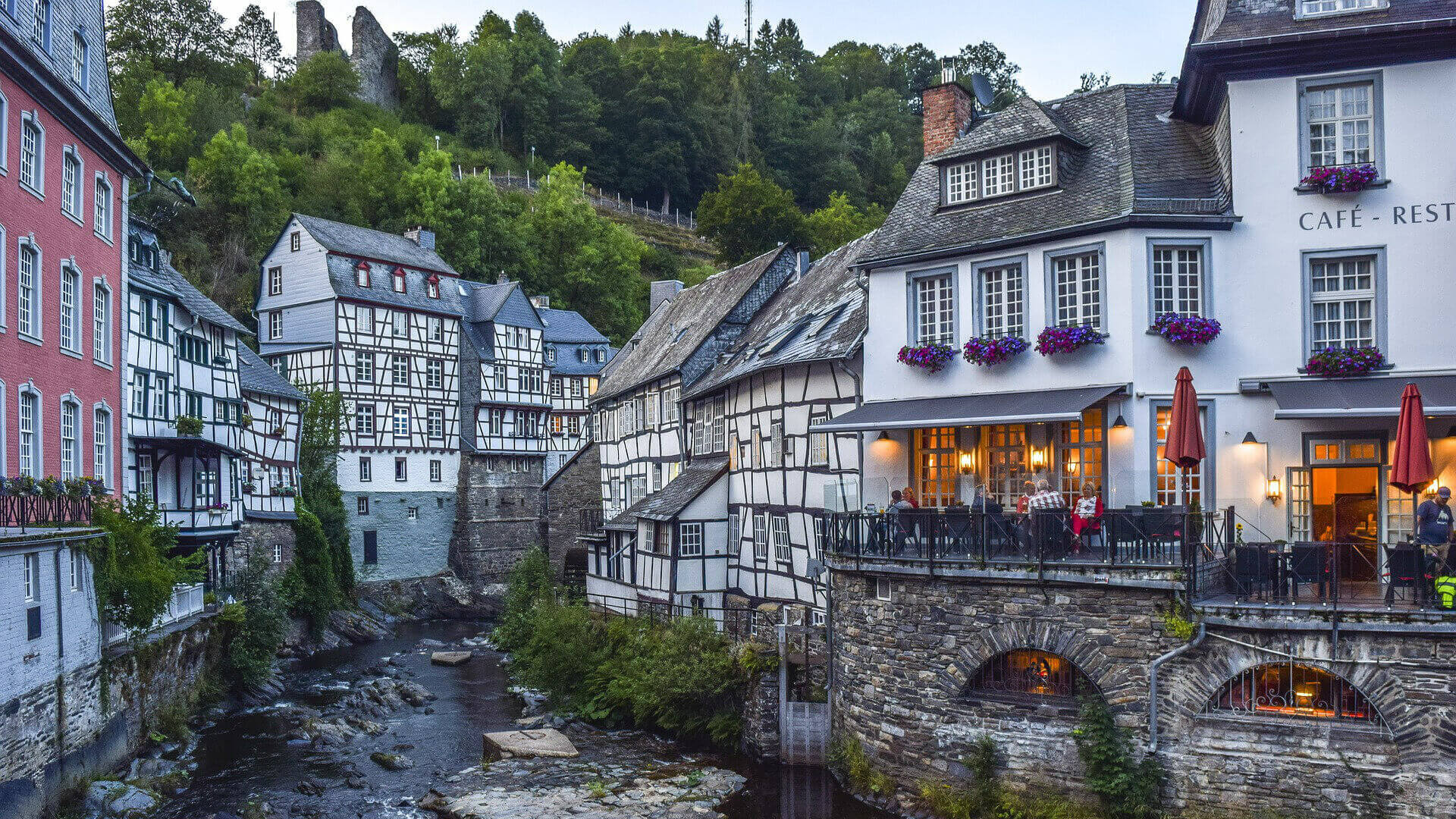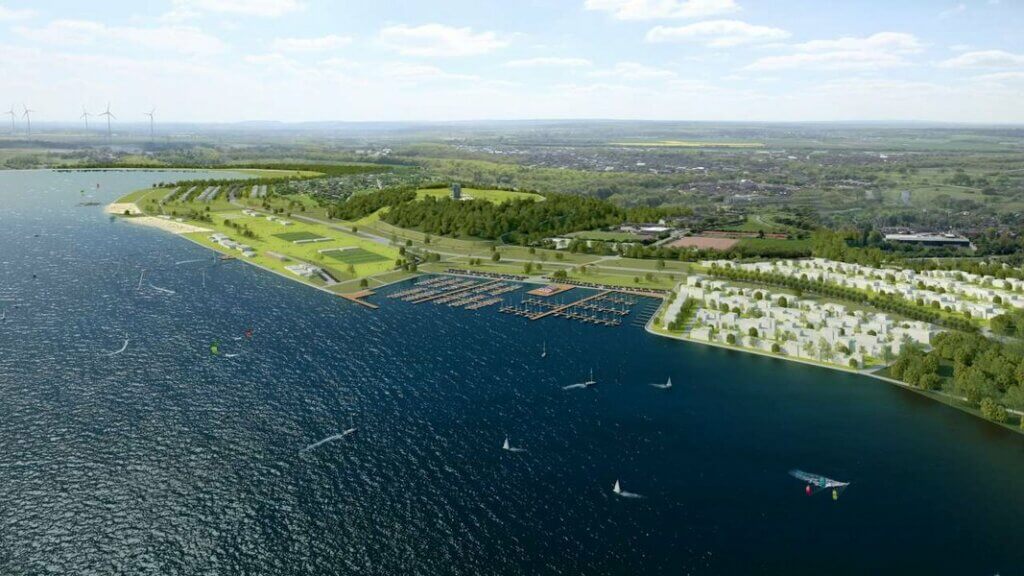Düren is a large county seat with over 90,000 residents in the city area and nearly 270,000 residents in the county area. Nevertheless, the city is not a household name to many, as it is located in the immediate vicinity of the cities of Aachen, Cologne and Bonn. Düren is an industrial location rich in tradition with about 11,000 employees in the manufacturing sector. Around 2,500 small to large companies are based in Düren, with the paper industry traditionally forming the center of Düren’s economy thanks to the particularly soft waters of the Rur.
History
Düren looks back on a long history dating back to a Neolithic settlement (ca. 5100 BC). In the year 747, Düren was mentioned in a document for the first time. During this time of the Franks, Charlemagne also came to the city. Around 1710, the first paper mill was built, the foundation stone for the structurally formative economic sector of the city and the surrounding area. In the following decades, Düren grew into a rich and influential business location with a large number of paper and cloth mills as well as metal processing companies. With its approximately 50 millionaires, Düren was considered one of the richest cities in Germany shortly before the First World War.
Today, Düren’s economy is multi-faceted: Companies based here are active in the chemical, automotive, mechanical engineering and healthcare sectors, in addition to the paper and machine industries. Owner-managed family businesses – including KST Moschkau GmbH – well-known global corporations and a large number of “hidden champions” are represented in Düren.
Location
Düren is located in the heart of Europe with almost 2,400 km to Lisbon (Portugal), 2,200 km to Reykjavík (Iceland) and 2,600 km to Athens (Greece). Therefore, and especially due to Düren’s good connection to the highway and rail network, KST is always on site with its customers at short notice.
But commuters also appreciate the short travel routes to nearby major cities such as Aachen, Cologne, Bonn and Düsseldorf and also the Eifel National Park.
It is not without reason that Düren is also called “the gateway to the northern Eifel”. The district of the same name is a member of the Euregio Meuse-Rhine and thus promotes exchange with the neighboring countries of the Netherlands and Belgium. Life in the border triangle offers the inhabitants a wide range of opportunities for leisure activities and economic development.
Numerous recreational areas
Burgau Castle, a moated castle located on the outskirts of the Niederau district of Düren, and the adjacent Burgau Forest are among the city’s most frequently used parks. A forest nature trail and a fitness trail invite visitors to discover the extensive forest, which is popular with the people of Düren. In addition, Burgau Castle and the Düren District Arena regularly host events.
There is much more nature to experience in the Eifel National Park, which invites not only to hiking and biking, but also to kayaking and sailing with its reservoirs and the Rur River. A special highlight is the 2019 recognition as an International Star Park by the International Dark Sky Association (IDA). The national park is consciously committed to the protection of the night sky and against light pollution.
The surrounding area of Düren offers many more natural, sporting but also historical experiences; these include the Drover Heath, the historic town of Monschau, Nideggen Castle, the LVR Open Air Museum in Kommern, the Bridgehead Park in Jülich as well as the grounds of the State Garden Show in Zülpich and the adjacent water sports lake.
Changing cityscape with interesting sights
During World War II, 99% of Düren was destroyed, making it the most heavily damaged city in Germany. However, some of the old baroque and art nouveau buildings were rebuilt and decorate the cityscape of Düren. These include the Leopold Hoesch Museum. The music school, the city mansions in Holzstraße and many mansions in the surrounding area. The most important museums also include the City Museum and the Paper Museum. The Inden open pit mine, located in the Düren district, is part of the Rhenish lignite mining area; several vantage points – including the “Indemann” viewing platform – provide a view of the open pit mine.
Medical infrastructure and education
The very good medical care in Düren is ensured by four public hospitals. These include the Düren Hospital on Roonstraße, the St. Marien Hospital in the Birkesdorf district, the St. Augustinus Hospital in Lendersdorf, and the LVR Clinic Düren for Psychiatry and Psychotherapy.
A positive feature of the city of Düren is the wide range of educational opportunities. There are a total of 33 general education schools in the Düren urban area, including five high schools. Early childhood education is provided in numerous daycare centers, which are free of charge for families with an annual household income of less than 120,000 euros. Three vocational colleges as well as the recognized private University of Applied Sciences for Small and Medium-Sized Businesses (FHM) and the external location of RWTH Aachen University in Jülich ensure vocational training and further education and contribute to the close interlinking of theoretical and practical vocational training in cooperation with Düren’s industrial companies. Through the research center located in Jülich, there is also close cooperation with RWTH Aachen University in the form of the Jülich-Aachen Research Alliance (JARA).
Variety of leisure activities: city of markets and Annakirmes
Family-friendliness is one of Düren’s leitmotifs: numerous activities and leisure opportunities focus on the family. First and foremost is the annual Annakirmes, which owes its name to the city’s patron saint, St. Anna.
The educational institutions of the two church communities have numerous early childhood education programs in their repertoire, and the gymnastics, dance, volleyball and soccer clubs in the district – above all the Dürener Turnverein (DTV) – offer children and adults the opportunity to keep fit and develop athletically. The Arena Kreis Düren, newly built in 2005, hosts concerts and comedy events (Mario Barth) as well as the home games of the SWD Powervolleys Düren – a Bundesliga team in men’s volleyball. The Düren bathing lake offers bathing fun for young and old and also open-air concerts by well-known artists (R.E.M., Peter Fox etc.) in summer.
Düren is also called the “city of markets“: In addition to the Düren weekly market (Tuesdays, Thursdays and Saturdays), the Düren Spring Festival, the May Market and the associated May Fair, the Düren Beer Market, Autumn Market and Christmas Market also attract numerous visitors.a For some years now, a street food festival has also been held in the city center, which has already attracted prominent TV chefs such as Johan Lafer to the city. Since the 1960s, the Dürener Jazztage and the annual city festival have also been a fixed institution in the leisure activities of the people of Düren.
Future in Düren
As part of the Rhenish lignite mining area, the district of Düren is particularly affected by a structural change that has already begun. A unique lake district is to be created in the area of the open pit mine, which is due to end in 2030, to ensure an attractive and efficient subsequent use. (https://indeland.de/indesee/zwischenlandschaft) The numerous science and research institutions in the district point the way to a climate-friendly, innovative and attractive future with future-oriented study focuses. In addition to the Jülich Research Center, the German Aerospace Center with the world’s largest artificial sun “Synlight” and the “Campus Aldenhoven” as a growing automotive location are particularly worth mentioning here. The technology company NPROXX, a leading manufacturer of hydrogen tanks, and the company StreetScooter, which produces all-electric vans in Düren, have chosen the district of Düren as their main location. In the future, StreetScooter also plans to develop and manufacture hydrogen-powered vehicles.
As a member of HyCologne Wasserstoff Region Rheinland e. V., the district of Düren is working on the widespread use of hydrogen technology. This includes a complete conversion of regional and local public transport as well as individual transport to alternative forms of propulsion. Hydrogen trains and buses are to be put into operation in the near future and a first hydrogen filling station is to be opened. The building permit for a solar park has already been granted, and the tender for the purchase of hydrogen is underway: The district is thus the first in NRW to enter the production of green hydrogen. KST is also committed to sustainability in a variety of areas. You can find out more here.














